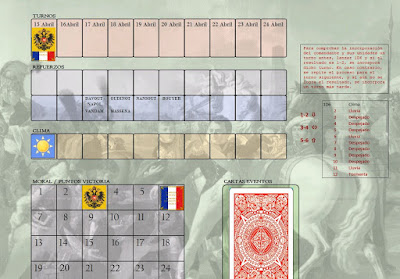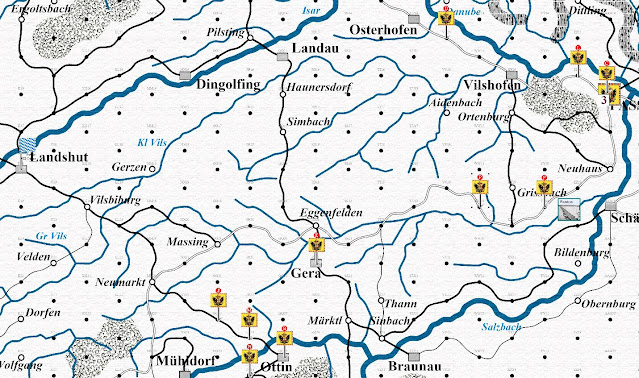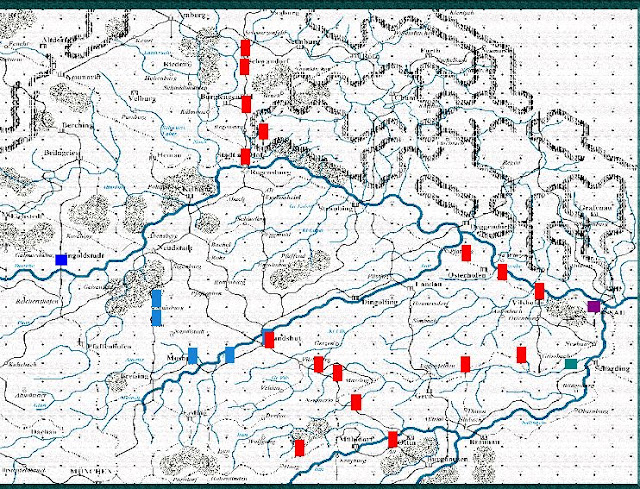For all those of you who have ever looked at this blog, it will seem that we have a fixation on this Napoleonic campaign from 1809. Fixation is not the concrete word, perhaps the desire to carry out a few-turns campaign but with a system that would be easy to implement, based on some wargame rules that have attracted us most attention in the past, as we wrote
in the last article.
In the end, we have been able to successfully develop this campaign, which has also served us to test this compendium of home-made rules for the campaign and correct some errors that have been made. The support we have chosen has been digital, with the Cyberboard application, already a bit old but it allows you to easily implement a simple board game like ours. The units are represented by flags, which was a mistake, because they didn't allow us to see behind them and therefore we had to have limited ourselves to the classic square counter pieces. The rest of the already known ingredients, event cards, markers for the weather, turns and victory points.
The map deserves a separate comment, since we have taken advantage of the Hexdraw software, to draw hexagon maps, but renouncing the typical hexagons to make it a point-to-point map, although of course with the hexagonal support. It is not an exact geographical map, logically, but the result seems more satisfactory than with other grid methods (square, offset squares, etc.) that we have previously tried in the past.
So this has been the solo Bavarian campaign 1809...
TURN 1
04/15/1809 - Clear weather
There are no event cards this first turn.

France: Lefebvre, commander of the Bavarian VII Corps, gets only 1PO [Lefebvre has 6 of value, he can roll 6 1d6, and the numbers >=3 are Orders Points or PO]
with which he moves the Deroi division from Rottenburg to 10 km from
Landshut to support the Wrede division. Probably the rest of the corps
will follow the next day, abandoning the possibility of defending
Regensburg, to avoid the possibility of being surrounded.
Austrian decoys have been deployed south of Landshut and north of Regensdburg, in a randomizing way (6 entry points to enter the map according a roll dice).

Red decoys and blue Bavarian troops.
The Austrian entry points in a zoomed area
TURN 2
04/16/1809 - Clear weather
Event card: "Mort au combat": As no combat occurs, it cannot be applied.
Reinforcements: None of the 3 reinforcements available, Davout, Napoleon or
Vandamme roll the required score of 1 or 2 to advance the initial arrival turn.
Lefebvre gets 3PO this time, with which he moves the artillery reserve and impedimenta towards Freising to contact the rest of the corps. The Prince Royal remains in Moosburg and Deroi's division crosses the Isar and leaves Wrede's division to hold out at Landshut to contain the Austrian advance and allow the Bavarian retreat to the west.
For their part, the Austrian decoys are already approaching the town of Vilsbiberg 20 kilometres from Landshut.
TURN 3
04/17/1809 - Clear weather
Event card: “Pont détruit”: Enables the player to destroy one of the bridges.
Reinforcements: Davout and Vandamme arrive with their army corps, as well as Oudinot who advances their arrival by 1 turn. Napoleon will arrive the next day having failed to obtain the required score.
Lefebvre gets 2PO this time, and withdraws the Deroi division crossing the Isar into Freising and takes advantage of the decoy's lack of Austrian presence to remove Wrede from Landshut. Davout gets 6 PO of his worth of 8 points and will attempt a defensive line between Regensburg and Donauwörth. Vandamme having obtained 3 POs, with the allies of Wurtemberg, will try to support him by moving from Donauwörth. Just as Oudinot that tries to support Lefebvre's Bavarian units
The decoy "J" has turned out to be a false rumor, so it has been removed from the board. The Austrians have managed to reach Regensburg, despite being somewhat late.
The global situation in the map in turn 3.
TURN 4
04/18/1809 - Clear weather
Event card: "Estafette" so another event card is chosen, which turns out to be "Reconnaisance" which allows one to discover one of the closest enemy decoys.
Reinforcements: Napoleon finally reaches Donauwörth, Masséna's VIII corps arrives at Augsburg and Nansouty cavalry at Pottmes.
Napoleon heads to Augsburg to join Oudinot's II Corps. Masséna obtains 5 POs with which he goes to Munich, to secure the capital and achieve his strategic objective [it was an error for next turns, to send all the units to Munich]. Oudinot (5 PO) continues on its way to Ingolsdtadt. Vandamme heads towards Ingoldstadt from the north bank of the Danube, but he doesn't get any POs, so he remains in the same place. Davout (3 PO) remains en route to Hemau. Wrede's division of VII Corps crosses the Danube and arrives in Freising to join the rest of Lefebvre's units.
The decoys continue their evolution but at a slower rate than required. Thanks to the event card we discovered the closest decoy, the "M", which also turns out to be a rumour without effect.
TURN 5
04/19/1809 - Clear weather
Event card: "Berthier faute!" as Napoleon is already on the board, the order to head towards Ingolstadt is ignored.
Reinforcements: No reinforcements, since Rouyer has not been able to arrive a turn earlier.
Davout with 4PO progressively approaches Regensburg. Vandamme with 6PO can head further towards Ingoldstadt with all of his units. Masséna (4 PO) tries to reach Munich before the Austrians. Napoleon uses his 7 POs to reach Oudinot's body and head towards Neudstadt, preceded by Nansouty. Lefevre places his units on the route from Freising to Neudstadt, in case their movement has to be north or south, depending on the moment.
The decoys continue their advance from Regensburg to confront Davout and from the South to try to conquer Ingoldstadt.
TURN 6
04/20/1809 - Rainy weather
Event Card: “Blesure” An enemy general loses his tactical bonus in a battle.
Reinforcements: Rouyer finally arrives in Augsburg. The entire French army is on the board.


Davout with 7PO retreats his advance towards Neumarkt, trying to concentrate all his army corps. Oudinot with 4 POs tries to reach Ingoldstadt, together with Napoleon. Masséna with 5 PO tries to secure Munich. Lefevbre moves its reserves north towards Neudstadt. Vandamme (3 PO) will continue north towards Eichstedt.
The Austrians for their part are grouped around Regensburg and the rest of the army continues its slow march north.
To be continued in Part 2...
- - - - - - o - - - - - -





















































